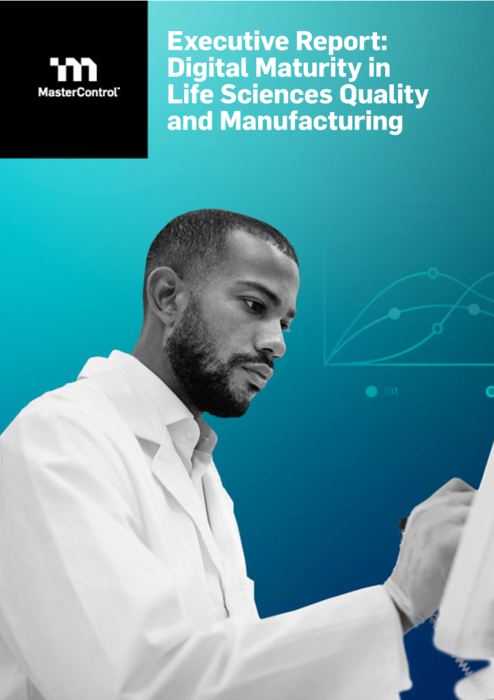
2024 Pharmaceutical
Industry Trends
Discover the latest pharma quality and manufacturing trends.
Some of the most sought-after human experiences are health and happiness. Although pharmaceutical companies can’t determine personal happiness, they are having more to do with personal health outcomes that can tip the scale. The demand for personalised medicines, cell and gene therapies, hyper- responsive and patient-centric healthcare, and real-world data fueled by artificial intelligence (AI) platforms and stored in the cloud are just some examples of the personal touch that is driving the future of pharma.
Companies will need to operate with lower costs and shorter timelines while maintaining quality and encouraging innovation. That means reimagining work, tech- enabling the organization, and advancing the portfolio to achieve multiple objectives imultaneously.
Common Challenges With Manual Systems
Pharmaceutical companies that adopt a modern MES overcome these issues.


Notable gaps in traditional quality management system offerings:
- 21% of quality organisations point to limited quality system and/or process data visibility as a very significant pain point.
- 25% of quality organisations confirm rigid or complex existing processes is a very significant pain point.
- In general, the more variable and situation-based a process is, the less often it is fully digitalised.
Technology Trends
Current technology trends are influencing consumer behavior and reshaping the way industry operates. Although pharma companies are working steadily to leverage the power of data and become more agile and resilient, there is still room for improvement.
Trending Topics
- Adopting Configurable LC/NC Solutions
Highly configurable low-code/no-code (LC/NC) solutions are becoming popular because they invite innovation by giving quality and manufacturing professionals direct control over process design and data management. These applications provide “a close fit to business requirements, can be implemented quickly, and typically cost much less than systems developed in-house,” according to professionals. 4
One interesting offshoot of adopting configurable LC/NC solutions is to attract, or rather curate, the industry's more technically savvy talent in to play the role of business developers – talent that is in short supply in biopharma, according to McKinsey. 5
- Leveraging Real-World Data
The cloud, personal devices, and apps are recording vast amounts of real-world data (RWD). The U.S. Food and Drug Administration (FDA) continues to prioritise methods to assess real-world data, develop advanced manufacturing approaches, and incorporate patient input. 6
Currently, the FDA is looking for near real-time surveillance of stimulants via the ToxIC Registry program and has also authorised the first medical devices to treat opioid use disorder (OUD). 7
- Practical Applications of Artificial Intelligence
A recent study found that small and large companies tend to use AI differently, but that AI solutions for pharma significantly increase efficiencies, and the potential applications are promising. 8
What will differentiate pharma manufacturers is how robustly they use modern tools like AI throughout their processes, including in production and quality control. 9 Implementing novel technology will need to unfold strategically. The key is to start with low- risk, high-priority business cases, such as document management, for example, or predicting training lapses and gradually move on from there. 10
The FDA cannot ignore that the science and context in which previous regulatory decisions were made has changed, and we must be flexible to evolve with the data.
Regulatory Trends
The key to pharma companies finding opportunities for growth is finding silver linings in regulatory challenges. Complementing regulatory efforts by promoting production and controls innovations will allow pharma leaders to improve patient outcomes and consequently extend their own reach.
Trending Topics
- The Drug Supply Chain Security Act (DSCSA)
The Drug Supply Chain Security Act (DSCSA) was implemented in 2013 by the FDA to help protect consumers from counterfeit, stolen, contaminated, and otherwise harmful drugs. 12 Following the FDA’s final guidance issued in September 2023 enables companies to more easily adopt secure, interoperable, electronic data exchange among the pharmaceutical distribution supply chain. 13
The European Union (EU) recently drafted the first legislation relating to the use of AI in the life cycle of medicines. 14 Members are hoping for agreement across the EU Council in preparation for discussions to establish the final form of the law. The new legislation seeks to outline levels of risk, transparency requirements, prevention of illegal content, and copyright infringement. 15 There is no question that governing bodies are anticipating AI will play an integral part in future business models. 16 Deloitte identifies one strategy to alleviate some of the legislator’s concerns of bias, overfitting, and data protection, namely applying low-code AI to common use cases rather than high-stakes endeavors. 17
2023 saw some surprising regulatory challenges in the U.S. 18 According to Kaiser, if FDA approval and marketing decisions can be overturned by private lawsuits, such rulings “could open up the drug regulatory process to allegations of violative behavior related to a range of perceived situations.” 19 The biomedical community may be able to offset threats to future access to treatment by infusing their processes with more verifiable data and providing real-world evidence (RWE) to make their own case for safe and effective high-demand products.
Actionable health insights, driven by radically interoperable data and artificial intelligence (AI), can help clinicians and consumers identify illness much earlier than we do today. Shifts in how diseases are identified, prevented, treated, or cured may lead to fundamentally different business models for traditional biopharma companies and new entrants.
AI is revolutionizing healthcare and manufacturing ... AI can help every sector gain insights into underused or unutilized resources, regular analysis, language and economic obstacles, and existing abilities, as well as achieve quality goals.
Therapeutic Trends
As the pharma industry strives to stay abreast of personalised patient needs, the number of holistic therapies dedicated to enhancing wellness – in addition to simply treating widespread disease – is rising.
Trending Topics
- Cell and Gene Therapies
Cell and gene therapy (CGT) has maintained a prominent space in the pharma landscape since 2021 and is projected to grow from $9 billion to $42 billion by 2030. 22 23 The regulatory framework, at least in the U.S., is poised to facilitate the development and approval of these therapies. 24 KPMG reports that while the appetite for autologous cell therapies is diminishing, innovation therapies with simplified manufacturing processes and supply chain complexities are in favor. 25
- Wellness Disruptors
According to Deloitte, sales volumes for drugs across disease areas are likely to decline over time with “more effective prevention, greater stratification of disease, better tailoring of drug regimens for patients, an increase in curative therapies, behavioral intervention, and advanced medical procedures.” 26 Pharmaceutical companies may be pressed to adopt alternative therapies or find uses in concert with personalised devices and/or wellness regimens to meet consumers' desires to stay healthy.
- Obesity and Addiction Treatments
The demand for drugs to treat obesity, such as Wegovy and Ozempic, is currently exceeding demand, even prior to final indication approvals. This is one area where pharma is finding success shifting into broader wellness initiatives, but also relying on personalised technologies to target phenotypes. “In two to three years, we’ll have drugs for each of these categories ... And there are lifestyle and diet interventions for each of the phenotypes that can also achieve results,” states Mark Bagnall, Phenomix Sciences CEO. 27 Time will tell if this targeted approach may also support recent initiatives by the FDA to combat addiction and opioid use disorder (OUD), which continues to cause high mortality rates. 28
As of August 2023, there have been six regulatory approvals of a cell or gene therapy between the U.S. and the EU, with up to 9 scheduled for approval in 2023 – matching the number of approvals by the FDA in the previous five years combined.
The expected burden of [mental health disorders] could be reduced by around 24% by 2040 using existing therapies and cognitive behavioral therapies alone. Development of novel therapies to address the remaining 76% would only increase the potential value of investment in this area.
There’s going to have to be a tool to sort out which patients get the right drugs. If you only get 20% of the market, but it’s the right 20% of the market, you’re going to dominate that part, and that’s where you find the value of precision medicine.
Economic Trends
Economic watchdogs report that there is slow overall deal activity due to tight capital, higher interest rates, inflation and pricing controls, and active enforcement by the Federal Trade Commission (FTC). 32 However, others suggest the emergence of smaller partnerships and timely divesting and reacquisition strategies can redirect investment toward profitable outcomes. 33 Technology solutions are playing a more significant role in biopharma portfolios. The emergence of generative AI, for example, has “added some effervescence to the market” as companies seek to understand how to integrate it and are “compelled to acquire expertise,” according to PwC. 34
Trending Topics
- Inflation Reduction Act (IRA)
The Inflation Reduction Act establishes a process for price negotiations and drug pricing controls for 10 drugs available to Medicare beneficiaries. It also revises Medicare Part D to provide less expensive coverage. This comes in response to concerns about the financial stability and overall health of older Americans, who may often skip or ration prescriptions because they cannot afford them in the United States. 35 Although this act is primarily aimed at opening market access, widespread ramifications will impact pharma companies’ commercial strategies and may inhibit research and development. 36 37
- Ongoing Pharma Supply Chain Management Challenges
Backlogs in global supply chains are leading to more competition for the raw materials pharma companies need. 38 Supply chain optimization, including more careful selection of suppliers, is a central concern. However, one of the most critical causes of drug supply shortage is much closer to home. In a 2020 report published by the FDA, economists examined 163 drugs that went into shortage over a four-year period. Sixty-two percent of them went into shortage only after supply was disrupted due to manufacturing and product quality problems. 39
- Reduced Investment and Increased Oversight
Increased U.S. federal government scrutiny limiting large M&A activity, IRA pricing concerns, delayed FDA approvals, and reduced investment in the biotech sector, are forcing the industry to redirect resources and evolve operationally to remain competitive. While large biopharmaceutical companies with equity and cash assets always have the advantage, 40 smaller biotech companies are experiencing large-scale layoffs and may need to confront reduced valuations in the near future. 41
Despite current cash scarcity, Ernest and Young is confident about the long term if biotech companies “can prioritise streamlining processes and the ongoing investment in organic innovation.” 42 Larger companies will continue to acquire early- to mid-stage assets, but are shifting their interest to areas where manufacturing and supply chain complexity is simplified. 43
Companies that truly scale and implement digital can better protect themselves from the pressures of the forces increasing costs for the industry. More and more companies are moving toward network-wide and end-to-end digitization ... the rewards can include significant cost savings, improved quality, and increased resilience, as well as greater employee effectiveness.
Quality improvements gained by manufacturers who fully digitised production:

Conclusion
While pharma has traditionally been characterised by costly and lengthy development cycles, ever-evolving demands, driven largely by needs for more personalisation, will require significant changes to pharmaceutical manufacturing and quality processes. The deeper digitalisation can go into these companies, the more personalised their products can become – more efficiently, and consequently less expensively. Reaching digital maturity remains the imperative to enable companies to respond more quickly with flexibility and agility, while remaining compliant and competitive.
Digital transformation in pharma is only expected to grow over the next few years to keep pace with current trends. Configurable solutions and intelligent platforms are making it possible to harmonise unique business processes with changing regulations and market demands. Now is the time to leverage professional expertise, differentiate, and expand your reach with a personal touch like never before.

